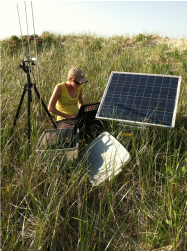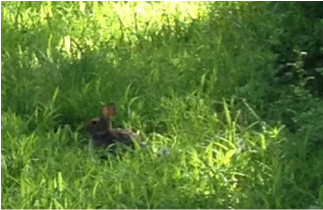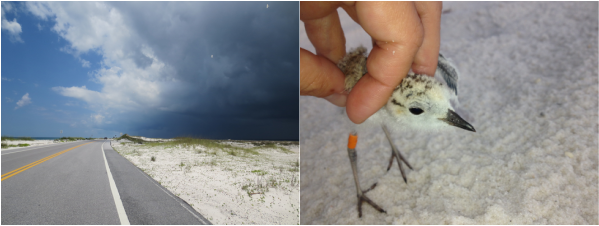| Dr. Cohen and Ph.D. student Amanda Cheeseman collaborated with a team of researchers on a successful proposal to the SUNY-ESF administered USDA McIntire-Stennis Grant competition that focused on using microsatellite DNA to quantify dispersal of New England cottontails from their home ranges. The relatively new technique was pioneered by scientists at the University of Idaho, as published in a recent Wildlife Society Bulletin article. |
Interdisciplinary Team Receives Grant to Use Genetic Methods for Studying Animal Dispersal3/26/2015
New England cottontails may disperse to new habitat in long distance movements of 100 meters or more, or may slowly bud a new home range off their existing one if there is adequate local habitat. Amanda will use radio-telemetry to quantify rates of long distance dispersal. To examine rates and spatial patterns of budding, she will compare DNA in pellets gathered during winter surveys to DNA in tissue collected from young and adult rabbits captured in the summer. Understanding dispersal patterns in this imperiled species is critical for planning restoration and protection of their habitat. The other researchers on the proposal were Dr. Christopher Whipps, a parasitologist and geneticist at SUNY-ESF, and Dr. Sadie Ryan, a spatial ecologist at the University of Florida.
Dr. Cohen has received funding from National Fish and Wildlife Foundation's Gulf Environmental Benefit Fund to continue studying wildlife road mortality at Gulf Islands National Seashore, FL. The National Fish and Wildlife Foundation (NFWF) received 2.5 billion dollars as the result of a plea agreement resolving the criminal case against BP for the 2010 Deepwater Horizon Oil Spill. This fund will be directed towards projects that will benefit the Gulf Coast's natural resources over the next five years. SUNY ESF collaborated with Audubon Florida to submit a proposal for the first round of funding in November 2013, which was successful. Preliminary results from a summer 2013 pilot study funded by the National Park Service found road mortality of shorebirds and seabirds at Gulf Islands National Seashore is likely higher than previously counts indicated, and that beach mice and reptiles are also affected. This study will also build on prior work on this site and continue to investigate snowy plover survival and reproductive success. This will allow for determination of the impact road mortality may have on snowy plovers at the population level.
Current lab member Maureen Durkin, who has spent the past 2.5 years working on her M.S. on human disturbance to snowy plovers at several sites in Florida, including Gulf Islands, will take on this project for her Ph.D. Maureen carried out the field work for the pilot study last year, and is excited to continue working with our partners at the National Park Service, Florida Fish and Wildlife Conservation Commission, US Fish and Wildlife Service, Florida Parks Service, and Audubon Florida. This year's field work will begin in early April and continue through August.  For her second field season studying piping plover movements and flight patterns in Massachusetts and New Jersey, M.S. student Michelle Stantial was able to build an automated telemetry system for monitoring radio-tagged plovers at her study sites. Michelle was awarded grants from the Goldenrod Foundation and the Garden Club of America to fund the telemetry station. She says of the system, "It helps us detect movements of piping plovers during times of poor weather and low-light conditions (times when birds are more susceptible to collisions with turbines). We leave it out on the beach and let it 'listen' to a bird with a telemetry unit for a few nights in a row, then we switch to another individual." Michelle's research will examine the implications of wind turbines piping plovers, specifically examining the potential for collision mortality if turbines are built in or near their habitat. |
Categories
All
Archives
July 2019
|


 RSS Feed
RSS Feed
